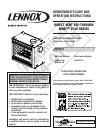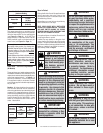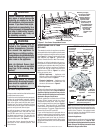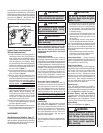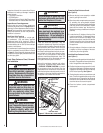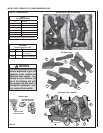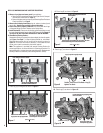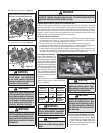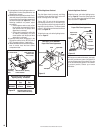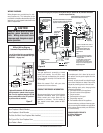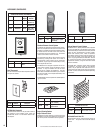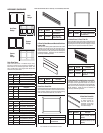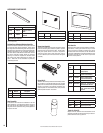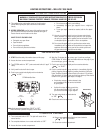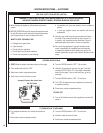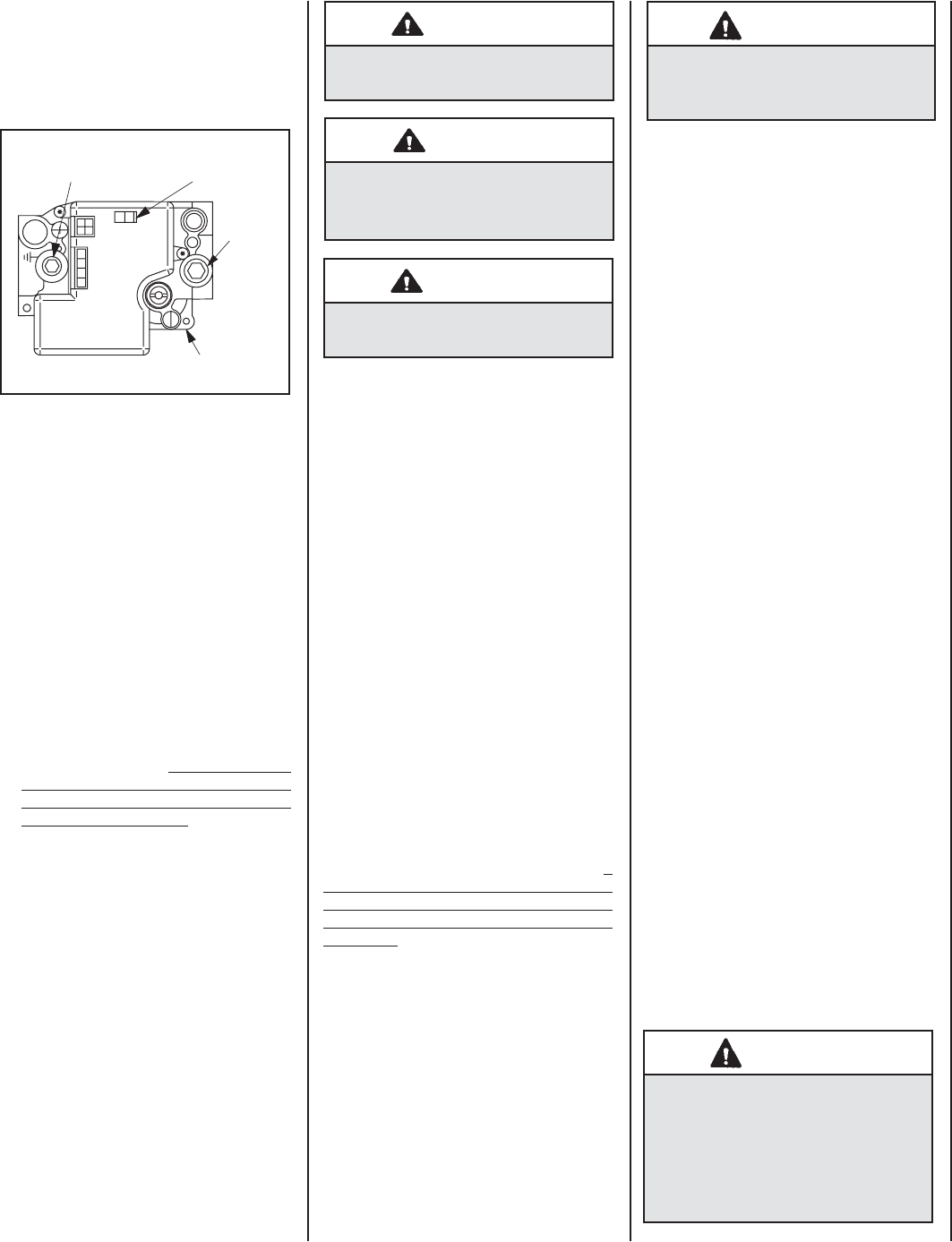
NOTE: DIAGRAMS & ILLUSTRATIONS NOT TO SCALE.
5
Figure 3
Honeywell Electronic Gas Valve
FFO
NI
PS
I
NO
L
O
R
T
N
O
C
G
I
N
T
I
ER
Manifold Pressure
Port
ON / OFF Switch
Inlet
Pressure
Port
Electronic Gas
Control Valve
Variable Flame Height Adjustment
(Millivolt Appliances only)
1. All Millivolt appliances are equipped with a
variable gas control valve. Flame height for
these models may be adjusted through a
range between fi xed low and high settings
while the appliance is in operation. Adjust
the fl ame height as desired after lighting the
appliance by rotating the variable adjustment
control knob (HI/LO) located on the front of
the valve (refer to Figure 2 ).
2. During the fi rst initial burns of these appli-
ances, there will be some odor emitted (see
Burn-In Period on Page 3 ).
3. Keep the lower control compartment clean
by vacuuming or brushing at least twice a
year. More frequent cleaning may be required
due to excessive lint from carpeting, bedding
materials, pet hair, etc. It is very important
that the control compartments, burners
and circulating air passageways of the
appliance are kept clean.
4. Always turn off gas to the pilot (millivolt
appliances) and let the appliance cool down
before cleaning. Before re-lighting, refer
to the lighting instructions in this manual.
Lighting instructions may also be found
on the pull out lighting instruction labels
attached to the gas control valve.
5. Always keep the appliance area clear and
free from combustible materials, gasoline
and other fl ammable liquids.
6. Remember, Millivolt appliances have a continu-
ous burning pilot fl ame. Exercise caution when
using products with combustible vapors.
Before re-lighting the fi replace, refer to the
lighting instructions in this manual. Instruc-
tions are also found on pull-out panels
located below the glass door in the control
compartment.
Inspect Venting System
The appliance and venting system should be
thoroughly inspected before initial use and at
least annually by a qualifi ed service technician
(inspection should include ensuring that exhaust
or intake passages are unobstructed and vent
components are properly assembled and not
damaged). If the venting system is disassembled
for any reason, a qualifi ed service technician
should follow vent installation instructions for
proper reassembly and proper sealing of the
venting system components. However, more
frequent periodic inspections and cleanings
should be performed by the homeowner.
Clean Lower Control Compartment
Keep lower control compartment clean by
vacuuming or brushing it out at least twice a
year (also clean the air venturi with a brush or
wire). More frequent cleaning may be required
due to accumulation of lint from carpeting,
bedding materials, pet hair, spider webs, etc. It
is very important that control compartments,
burners, circulating air passageways and air
venturi on the appliance are NOT obstructed
in any way.
Cleaning Glass
(see Front Glass Enclosure Panel, Removal
and Installation on Page 6) Note: Clean glass
after fi rst two weeks of operation (after Burn-In
period is over) and then only when necessary
and when the fi replace is cool. Wipe surface
with clean, dampened, soft cloth. Follow with
dry, soft towel as desired. Take care not to
scratch the glass surface.
The viewing glass should be cleaned periodi-
cally to remove any build-up caused from the
following:
WARNING
Turn off gas and electrical power
before servicing the appliance.
CAUTION
Wear gloves and safety Glasses
for protection while doing
required maintenance
.
IMPORTANT
Always verify proper operation
after servicing.
IMPORTANT
Do not use abrasive cleaners
on glass. Never clean the glass
when it is hot.
• During start-up, it is normal for condensa-
tion to form on the inside of the glass (this
condensation and fog will usually disappear
in a few minutes). The moisture can cause
lint, dust and other airborne particles to cling
to the glass surface.
• Initial curing of the high temperature paint
and burning off of lubricants used in the
manufacturing process may result in a fi lm
on the glass.
• A white coating may form on the glass as a
result of impurities and minerals in the fuel.
It is recommended that the glass be cleaned
two or three times during each heating season,
depending on the circumstances present. The
following cleaning solutions are approved for use
to clean glass:
• Non-ammonia based household cleaner
• 50%-50% mix of white vinegar & water
• gas fi replace/stove glass cleaner
Inspect Glass Gasket - Visually inspect the
gasket on the backside of the glass enclosure
panels. The gasket surface must be clean, free
of irregularities and seated fi rmly.
Clean Logs And Burner
Carefully remove the logs (use care when han-
dling the fi ber logs, as they become quite fragile
after curing). Vacuum out any foreign matter
(lint, carbon, etc.) on the burner. Ensure the
burner ports are “open.” Remove any carbon
deposits from the under side of the logs using
a vacuum cleaner, or a soft bristled brush (i.e.
paint brush). Note: Improper positioning of
logs can create carbon build-up and will alter
the performance of the appliance.
Replacing Logs -
If the logs become damaged by accident or
improper handling and need replacement, use
only the proper replacement logs from manufac-
turer (see Page 20 for ordering information).
Re-Install Embers, Logs and Vermiculite
- Carefully follow placement instructions on
Pages 7 to 9 ). All logs should fi t onto cor-
responding pins and/or log stoppers. This will
ensure a proper fl ame and safe combustion.
Inspect Wiring
Refer to wiring diagrams on Page 11.
MAINTENANCE
(See Maintenance Schedule, Page 17)
Refer to the maintenance schedule for maintenance
tasks, procedures, periodicity and by whom they
should be performed. Always verify proper opera-
tion of the appliance after servicing.
WARNING
Label all wires prior to discon-
nection when servicing con-
trols. Wiring errors can cause
improper and dangerous opera-
tion. Verify proper operation
after servicing.
Once the pilot is lit, if your electronic appliance is
equipped with an optional burner control switch
kit the appliance main burner may be turned on
and off using the optional switch (See optional
accessories on Page 12 - Wall Switch, Wall
Thermostat Or Remote Control Receiver).



